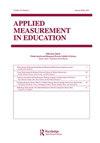测试时间、休息时间和成绩之间关系的普查水平多层次分析
IF 1.1
4区 教育学
Q3 EDUCATION & EDUCATIONAL RESEARCH
引用次数: 1
摘要
美国的几个州已经取消了州评估的时间限制。在印第安纳州,这项研究进行的地方,州评估在测试窗口期间是不定时的,并且在测试期间允许无限的休息。本文使用三年级和八年级的数学和英语状态评估数据,重点关注用于测试的时间,并检查花费更多时间的学生是否倾向于优于同龄人。此外,我们还研究了学生休息的次数是否与学生的成绩分数有关。研究结果表明,即使在不定时的情况下,花在评估上的时间与学生和学校的成绩之间仍然存在很强的联系。另一方面,在控制时间后,休息的次数与成绩几乎没有联系。论文最后讨论了研究结果的政策含义。本文章由计算机程序翻译,如有差异,请以英文原文为准。
A Census-Level, Multi-Grade Analysis of the Association Between Testing Time, Breaks, and Achievement
ABSTRACT Several states in the US have removed time limits on their state assessments. In Indiana, where this study takes place, the state assessment is both untimed during the testing window and allows unlimited breaks during the testing session. Using grade 3 and 8 math and English state assessment data, in this paper we focus on time used for testing and examine whether students who take more time tend to outperform their peers. Further, we also examine if the number of breaks students take is associated with student achievement scores. Findings suggest that even in an untimed setting, there remains a strong association between time spent on the assessment and achievement at both the student and school level. The number of breaks, on the other hand, show little to no association with achievement after controlling for time. The paper concludes with a discussion of the policy implications of the findings.
求助全文
通过发布文献求助,成功后即可免费获取论文全文。
去求助
来源期刊

Applied Measurement in Education
Multiple-
CiteScore
2.50
自引率
13.30%
发文量
14
期刊介绍:
Because interaction between the domains of research and application is critical to the evaluation and improvement of new educational measurement practices, Applied Measurement in Education" prime objective is to improve communication between academicians and practitioners. To help bridge the gap between theory and practice, articles in this journal describe original research studies, innovative strategies for solving educational measurement problems, and integrative reviews of current approaches to contemporary measurement issues. Peer Review Policy: All review papers in this journal have undergone editorial screening and peer review.
 求助内容:
求助内容: 应助结果提醒方式:
应助结果提醒方式:


